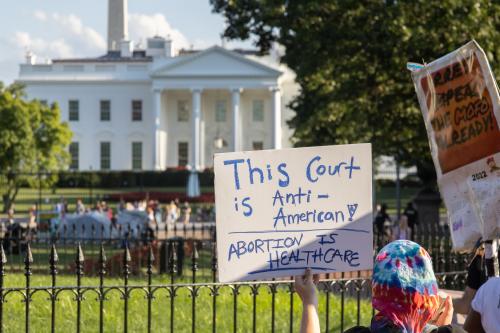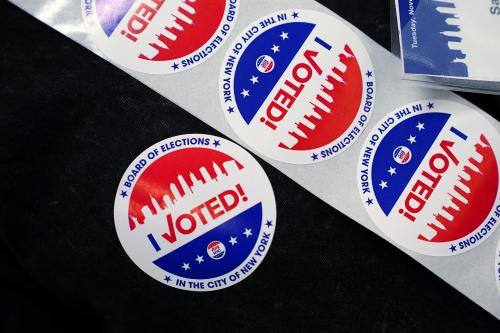As more data becomes available, a clear picture is emerging for Latino voters suggesting Democrats are projected to obtain a smaller percentage of the Latino electorate this cycle than in years past. The National Association of Latino Elected Officials’ (NALEO) national Latino voter tracker poll suggests that Latino voters continue to favor Democrats (55%) over Republicans (30%)—with the other 15% undecided. However, unless most of the undecided vote goes to Democratic candidates, Republicans will have improved on their 2018 performance with Latino voters.
This post utilizes NALEO’s survey data to further explore shifts in Latinos’ projected voting behavior and which factors help explain improved GOP vote share among Latinos, with a particular focus on Latinas.[1] The dive into the data reveals that abortion policy may provide Democrats their best chance of having Latina support for their candidates at similar rates to prior elections. However, despite overwhelming support for policy issues on the Democratic agenda, due to improved views of the Republican Party, Latinas are projected to demonstrate their highest level of Republican support in several election cycles.
Latino voting trends over time show significant movement among Latinas
As the figure below makes clear, Republicans have clearly gained significant ground since the last midterm cycle. At the same point in the race in 2018, 71% of Latino voters said they were supporting Democrats for Congress, compared to just 20% for Republicans. As reflected in the figure below, 70% of Latinos reported voting for a Democratic House candidate in the 2018 Election Eve Poll. With 11% undecided at this stage in the campaign, there is room for Democrats to get closer to the 65% (or higher) Latino voter margin that they are used to capturing based on recent election cycles, but with only 54% voting Democrat at this point in the race, the underlying data suggests that this may not happen in 2022.
Latinos are, of course, a very diverse electorate with important variation in their voting behavior. Cubans remain distinct from other Latinos, with Cuban support for Democrats at 35%, according to the NALEO tracker poll. This helps explain why Florida is an outlier in pre-election polling of Latinos, where Latinos are slightly more partial to Republicans. However, the real story, in my opinion, is regarding gender differences among Latinos.
As reflected in the figure below, the steady decline in Latina support for Democratic House candidates is noteworthy. The 2016 election was a high point for Latina Democratic support, reaching 88% and fueled largely by having Hilary Clinton at the top of the ticket. In 2018, Latinas continued to support Democratic House candidates at a high level (77%), but the 10% drop from 2016 was part of the larger improvement Republicans had with Latinos in 2016.
The shift in the political behavior of Latinas helps explain the overall movement of Latinos toward the GOP, and this decline may continue in 2022 if the trends in the NALEO tracker poll hold through Election Day. In fact, even if Latinas surpass 60% Democratic support in 2022, we will still be talking about a double digit decrease in Latina Democratic support in the last off-year election.
Although Democrats remain more favorable to Latinas than to Latino males this cycle, the gap between the two Latino subgroups is only 2% as we approach the final weeks of the 2022 campaign (56% and 54%, respectively). This is a decrease from the 10% gap in 2016, when 88% of Latinas reported voting for a Democrat in their House race.
What explains latinas’ movement toward Republicans?
Interestingly, this improvement for Republicans among Latinas is not a result of a movement in Latino policy views, but a shift in views about the Republican Party. When asked about key policy issues this cycle, Latina voters (like Latinos overall) expressed overwhelming support for advancing several current social causes, which suggests Latinos support a progressive/liberal policy agenda. This includes 88% support for allowing Medicare to negotiate lower prices on prescription drugs and 78% support for protecting DACA recipients from deportation, among others included in the NALEO tracker poll.
Despite strong support for these policies that are part of Democratic candidates’ platforms this cycle, we see a significant improvement in general views of the Republican Party among Latina registered voters.
Back in 2018, 37% of Latina voters reported feeling that the Republican Party was hostile to their community, compared to just 27% who felt the same in the NALEO tracker this cycle. This is consistent with most of the polls I have seen over the last two months of Latino/a voters, so there is a steady trend in the data that lines up with the drop in Democratic support since 2018 among the Latino electorate.
Republicans also appear to have improved their contact rates toward Latinos in their efforts to court voters this cycle. Republican outreach accounted for 39% of all outreach reported by Latinos in the latest poll; this is a 12% increase from the same point in the 2018 election. When we look at contact rates by gender, both parties could improve their outreach to Latinas. Contact from Democrats is 5% lower for Latinas than for Latino males. Contact from Republicans is 4% lower for Latinas than for Latinos.
Latinas prioritize the economy, abortion rights, and addressing gun violence
Both parties would be wise to be responsive to Latinas’ policy interests to improve their standing with the key subgroup of the larger Latino electorate.
A third (33%) of Latinas report that their financial situation has gotten worse over the past two years since the last election, 8% more than Latino men, who were also more likely to report that their situation has improved relative to Latinas (+11%). This is consistent with a wider set of research findings that show Latinas have seen their economic wellbeing devastated during the pandemic, with inequalities in economic challenges across most measures of economic stress, including higher rates of job loss and depressed wages due to long COVID-19 symptoms. It is therefore not surprising that the rising cost of living/inflation is the number one issue for Latinas (like it is for Latinos overall) this cycle.
According to the UnidosUS/Mi Familia Vota National Survey of Latino Voters, Latinas overwhelmingly support a range of temporary relief programs and benefits, including expansion of the Child Tax Credit, housing rental assistance, and unemployment benefits and are more supportive of each policy than Latino men. Latinas have been key to the growth of small businesses across the country, but Latina small business workers have experienced far more challenges during the pandemic. Finding paths to support Latinas starting their businesses will help capitalize on the higher desire to become entrepreneurs and business owners that Latinas have demonstrated, and whichever party delivers on improving Latinas’ economic standing may see long-term benefits from that outcome.
Addressing gun violence and mass shootings is the third-highest priority for Latinas this cycle, with Latinas being 7% more likely than Latino men to identify gun violence or mass shootings as a top issue (see figure above). The Abriendo Puertas/UnidosUS National Latino Family survey found that an astonishing 17% of Latina mothers have been present at a school or public place when a shooting incident occurred. These personal experiences with gun violence have led to greater support among Latinas for banning assault rifles nationwide than Latino males—74% compared to 68% according to the NALEO tracker. This is, therefore, another policy area where both parties should focus their energy following the midterms in order to engage Latinas’ policy priorities.
Democrats have made reproductive health their main policy area of focus in outreach to Latino voters. A major question going into the final week of the 2022 campaign season is whether this strategy will pay off and yield Democratic vote share comparable to years past. As I have discussed in a prior post, abortion is a policy area that has emerged as key to Latino voters this cycle. This is particularly true for Latinas, who are 13% more likely than Latino men to identify women’s reproductive/abortion rights as a top priority, with this issue area trailing only inflation among Latinas’ policy priorities this cycle in the NALEO tracker poll. Furthermore, 74% of Latinas support passing a law to guarantee access to abortion.
The Democrats’ strategy is therefore ideally suited for the Latina electorate. That will make a lack of improvement in Democratic vote share among Latinas painful for Democrats in 2022, and without seeing improvement among Latinas, Republicans may be poised for a big election night. However, the focus on reproductive health may help Democrats minimize their losses in the House, if the issue continues to energize Latinas through the final days of the campaign.
The survey data referenced herein was produced independently by a third-party firm, BSP Research on behalf of the National Association of Latino Elected and Appointed Officials. Outside of his work at Brookings, Dr. Gabriel Sanchez serves as Director of Research for BSP Research which designed and implemented this survey. Sanchez had no role in the design or implementation of this survey.
Footnotes:
[1] Because NALEO has followed the same methodology for their Latino polling over the last several election cycles, we have a good barometer for determining how things look relative to prior election cycles.
The Brookings Institution is committed to quality, independence, and impact.
We are supported by a diverse array of funders. In line with our values and policies, each Brookings publication represents the sole views of its author(s).








Commentary
Will Democratic focus on abortion policy help reverse decrease in Democratic vote share among Latinas over time?
November 3, 2022